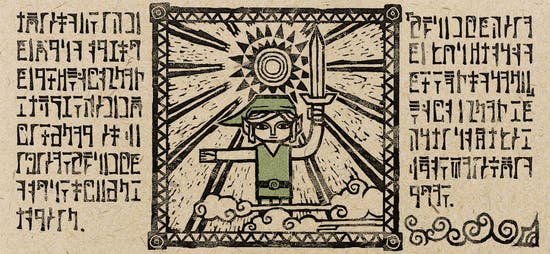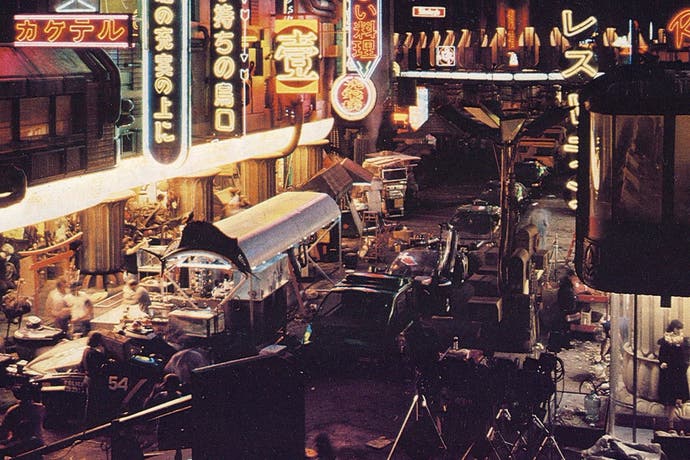Imagining and deciphering writing systems for games
From Zelda and The Witcher to The Elder Scrolls and Sethian.
Invented languages have been a part of fantasy storytelling at least since Tolkien wrote his Middle-Earth stories. By now we're all used to the idea that one way to make your imagined world feel real but unfamiliar is to invent a new language for at least some of its inhabitants to speak - usually the ones you consider the strangest and most 'other'. So Tolkien's elves have their Quenya and Sindarin; Game of Thrones has Dothraki and Valyrian, and in sci-fi there's the famous Klingon language, or, more recently the interesting creole spoken by the Belters in The Expanse.
As a world-building technique, invented languages obviously work. But they have their limitations too. Done badly, they can sound silly and off-putting; even done well, they can be hard for actors to work with, turning carefully-scripted dialogue or meaningful speeches into stilted and tedious nonsense (Star Trek: Discovery, stop shuffling at the back).
So another option is to make it purely visual. As visualised language, writing can achieve a similar sense of place and culture to spoken language, but woven into the overall art-design. Sometimes you can do this with real writing systems in unfamiliar contexts, such as the ubiquitous Far Eastern scripts of post-Blade Runner Cyberpunk futures; but more often in science fiction and fantasy, designers create their own entirely original writing systems, like Star Wars' Aurebesh or Doctor Who's various Gallifreyan scripts.

As a largely visual medium concerned with creating imaginary worlds, it's no surprise that games do this a lot. What's more, games are interactive, so they can ask players to engage with their invented writing systems in ways that books or film can't. Sure, more often than not it's little more than set-dressing, but the option is there to make deciphering their scripts part of the gameplay itself.
So, how do games' invented writing systems stack up? The fantasy genre's the obvious place to start. Countless RPGs and adventure games use made-up writing as part of their visual design, from Myst to Zelda to the Elder Scrolls series.


But it's not just them. Even sci-fi shooters like Halo have had a go. If we want to cast our definition of games a bit more broadly, Star Wars' Aurebesh was first properly systematised for use in table-top RPG and miniatures games.
What all these writing systems have in common is that they don't tend to deviate too far from the familiar. Some are little more than highly abstracted fonts for existing writing systems, like the Ancient Hylian of Breath of the Wild.

More often, the signs themselves are original creations, but they still map straightfrowardly onto our own alphabet, making the invented script essentially a substitution cipher. This has the obvious advantage of being easy to work with, since it can be created as a normal font that can simply be applied to text. It also makes it easy for interested players to decipher the text and find the 'hidden' messages throughout the game world. It can feel a bit simplistic, though, compared to all the variation we see in real writing-systems. Alphabets are only a small part of a dazzling ecosystem of types of writing, from pictograms and logograms to syllabaries and abjads. Many systems are complex mixes of several of these. Even alphabets themselves differ massively in their number of letters and the sounds they represent.
There are some games that move beyond simple substitution ciphers and do something a bit more interesting with their writing systems. The Witcher games, for instance, turn to history and use the early Slavic Glagolitic alphabet for their in-game writing, while The Legend of Zelda: Ocarina of Time and Wind Waker eschew alphabets altogether. Their versions of Hylian are syllabaries, where each sign represents a whole syllable rather than a single letter, working along similar lines to Japanese but considerably simplified.

So, lots of games use writing for background colour and world-building. But what about those that weave game mechanics around it? There's something wonderfully puzzly about deciphering an unknown writing system. No wonder, then, that several games have incorporated their writing into puzzles. Myst and its sequel Riven had a few puzzles that involved making sense of writing, usually the numbers, and more recently Fez asked players to understand and answer questions entirely in its made-up writing system.
There's been at least one attempt to build a whole game around deciphering an ancient and unknown writing-system. 2016's Sethian is played entirely in an invented writing system far more complex and unfamiliar than the usual substitution ciphers. The player interacts with the AI of an extinct alien civilisation and must talk to it and uncover the secret of the aliens' disappearance. It is, effectively, a chatbot that communicates entirely in a made-up writing system. Sethian's writing is ideographic - each sign represents an idea like 'ascend' or 'person' rather than a sound.

Sethian is a very clever and very interesting game, and unquestionably the one I've come across that treats writing and decipherment in the most sophisticated way. At the same time, though, it's also a frustrating experience, and not just - I hope - because I'm not very good at it. Its main problem is that its puzzle is so pure and self-contained - everything about the writing-system has to be understood just from the writing itself. Your main tools to do that are interacting with the AI chatbot - which has all the foibles of interacting with any other chatbot: you'll rapidly learn the 'I don't understand that question' response - and looking up signs in a notebook which magically fills up for you. What the game doesn't give you is cultural context. There's a whole alien world out there, but you can't see it. Your notebook contains references to scholarly debates or cultural influences on this alien civilisation, but you can't read them in full. As a player, you know less than the character you're supposed to embody.
In trying to understand real-world examples of unknown or ancient writing, linguists are increasingly focusing on the importance of cultural context and thinking about writing and language not as abstract puzzles to be solved, but embedded in, and connected to, every other aspect of a culture, from its art and ideas to its archaeology and architecture (cards on the table: this is actually my day-job). Usually, when someone makes a breakthrough, it involves at least some of that knowledge. Let me give a real example. For a very long time, it's been known that our alphabet came to Europe from what's now Lebanon, Syria and Israel. But how it developed there was a mystery. In the early 20th century Egyptologists were able to identify some very ancient inscriptions in caves in the Sinai peninsula as the earliest known example of what would develop into our alphabet. They're still very difficult to read, but the connection was made because they knew that people from the Levant had worked in Egyptian turquoise mines in the area, and the linguists were able to identify a phrase as a dedication to a Canaanite deity.
That's not to say writing is never deciphered purely on its internal logic, but these examples are very rare and works of special genius. Perhaps the most brilliant example is Linear B, the writing system used in the Mycenaean palaces of the Late Bronze Age Aegean (about 1200 BC).

Linear B is a mixed system of syllables and logograms, unrelated to any modern writing. Linguists had no idea what language it represented, but based on their understanding of the region's prehistory, they were sure of one thing: it couldn't possibly be Greek. The best bet was that it was related to another unknown language - Etruscan. In 1952, in an incredible feat of cryptanalysis the English architect Michael Ventris succeeded in deciphering Linear B based on internal correspondences. He announced his success on BBC radio and it's well worth a listen. Ventris demonstrated the exact opposite of what everyone took for granted:
Linear B represented an early form of Greek, even more archaic than Homer. Within the world of language and writing decipherment, Ventris is rightly hailed as a genius. But genius is not the norm. The vast majority of ancient writing isn't deciphered like that. Usually we have some way in - we know what language it's in, or some of the signs are familiar because they're used by a writing system we do know, or if we're very lucky we might have a Rosetta Stone-type key where the same text appears in different languages and kinds of writing.
For all its cleverness, this is what Sethian gets wrong: its writing is shorn of cultural context and presented purely as a puzzle. It's intriguing and ingenious but it feels a bit like decipherment as imagined by mathematicians or computer scientists, not the humanist reality. If we're to have games where imagined writing feels satisfying and deep and reflects something of how we encounter and understand unfamiliar writing systems in reality, we need to chart a middle path - the depth and complexity of system seen in Sethian combined with a sense of art, history and writing-in-the-world that's more familiar from ostensibly more simplistic portrayals. Of course, that's not a level of depth every game needs, but as game environments become more richly-imagined and more invested with world-building and story, it would be a fascinating thing to see.

